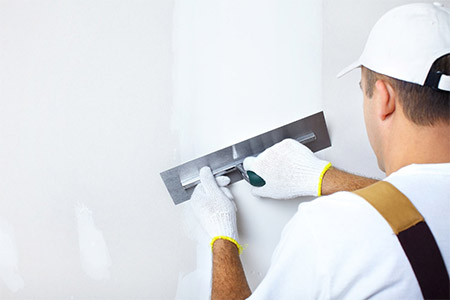Everything about Plasterer
Table of ContentsThe 8-Minute Rule for PlastererAn Unbiased View of PlastererHow Plasterer can Save You Time, Stress, and Money.The 25-Second Trick For Plasterer
After the workplace is floated, the surface area is completed with a damp sponge making use of the same method as floating with a wood float, bringing sand to the surface to provide a smooth constant coating. Materials used in the make are frequently neighborhood sands with little clay content with fine to coarse grains.Plasterers use a t-bar to screed the walls till it is plumb, straight and also square. 2 coat is superior as, although extra expensive, it gives a much more constant finish and has much less possibility of becoming drummy or fracturing. Drumminess happens when the render does not bond entirely with the wall, either since the wall is as well smooth, a layer is too thick, or the layer is being floated when the make has actually solidified way too much, leaving an air area that makes a drumming sound when a steel tool is "massaged" over it.
Nevertheless, rather than being completed with a sponge, the 2nd coat is left harsh and also often will certainly be racked up by nails put in the float. After drying, the surface is after that scraped to get rid of loose grains of sand prior to gluing. If the walls are concrete, a dash coat is needed to make certain bonding.
Unique mixes are often needed for architectural or useful reasons.
The Definitive Guide to Plasterer
The miters at the angles are completed off with joint guidelines made of sheet steel of various sizes, 3 or 4 inches (102 mm) broad, and also about one-eighth inch thick, with one end cut to an angle of regarding 30. Sometimes the steel plate is let into a stock or deal with of hardwood.

The modern usage of this material might be claimed to have begun then, however making use of coarse plaster was recognized and exercised by the Egyptians long prior to the Christian age; for old coffins and mommies still preserved confirm that linen tensed with plaster was made use of for embellishing caskets and also making masks.
Canvas and mortar remained in basic usage in Great Britain up to the center of the 20th century. This work is additionally much utilized for short-lived work, such as exhibit structures. There are 2 main techniques in U.S.A. utilized in construction of the interior wall surfaces of modern homes, plasterboard, likewise called drywall, and veneer this article plastering.
See This Report about Plasterer

At the place where both sides of wallboards fulfill there is a seam. These seams are covered with mesh tape and after that the joints as well as the screw heads are concealed with the drywall compound to make the wall surface appear as one attire piece. The drywall plaster is a thick paste.
This process is usually called "taping" and those that utilize drywall are understood as "tapers". Veneer plastering covers the whole wall surface with slim liquid plaster, uses a lot of water and is applied very wet. The wall surfaces meant to be glued are hanged with "Blueboard" (named therefore for the market requirement of the outer paper being blue-grey in color).
Veneer plastering is a one-shot one-coat application; taping generally needs sanding and after that adding another layer, considering that the compound diminishes as it dries (Plasterer). The plasterer usually appears after the wall mounts have actually completed developing all the internal walls, by attaching blueboard over the structures of your house with screws. The plasterer is typically a subcontractor working in crews that average concerning 3 veterans as well as one worker.
Debris left on the floorings from the "dangling" crew need to be removed before flooring paper can be put down and to eliminate any kind of tripping risks. Cover the floorings with tar or brown paper considering that plaster can tarnish or be hard to eliminate from subflooring plywood. Run hoses and also expansion cords and established up work lights.
Top Guidelines Of Plasterer
Set up for the following mix. As quickly as the YOURURL.com table is cleared the laborer is provided guidelines of how lots of bags will be needed in addition to the next space to be functioned in. The table typically is composed of folding legs upon which is set a square board of wood as well as then covered in a plastic sheet upon which the plaster is put in the center in a big pile.
The blending barrel is normally pre-filled to a specific degree with water; given that it can spend some time to fill (Plasterer). The quantity of water is usually approximated (with a margin of error leaning towards too little). The amount of water called for is acquired from the amount of bags planned to be blended.
With an irreversible staff that usually does the exact same amount per mix one can merely load up the barrel to a well-known cut-off point. Once the mix is established up as well as the plasterers are ready they advise the worker to start unloading the bags in the water barrel, while periodically running the mixing drill.
At a certain factor prior to the mixing is done a margin trowel is again made use of additional reading to scuff any clinging completely dry plaster into the rest of the mix. typically this is when the accelerator; if used is included - Plasterer. Mixing can be fatigueing because the drill has a tendency to not only be hefty but the mixer has to likewise battle the torc of the paddle.